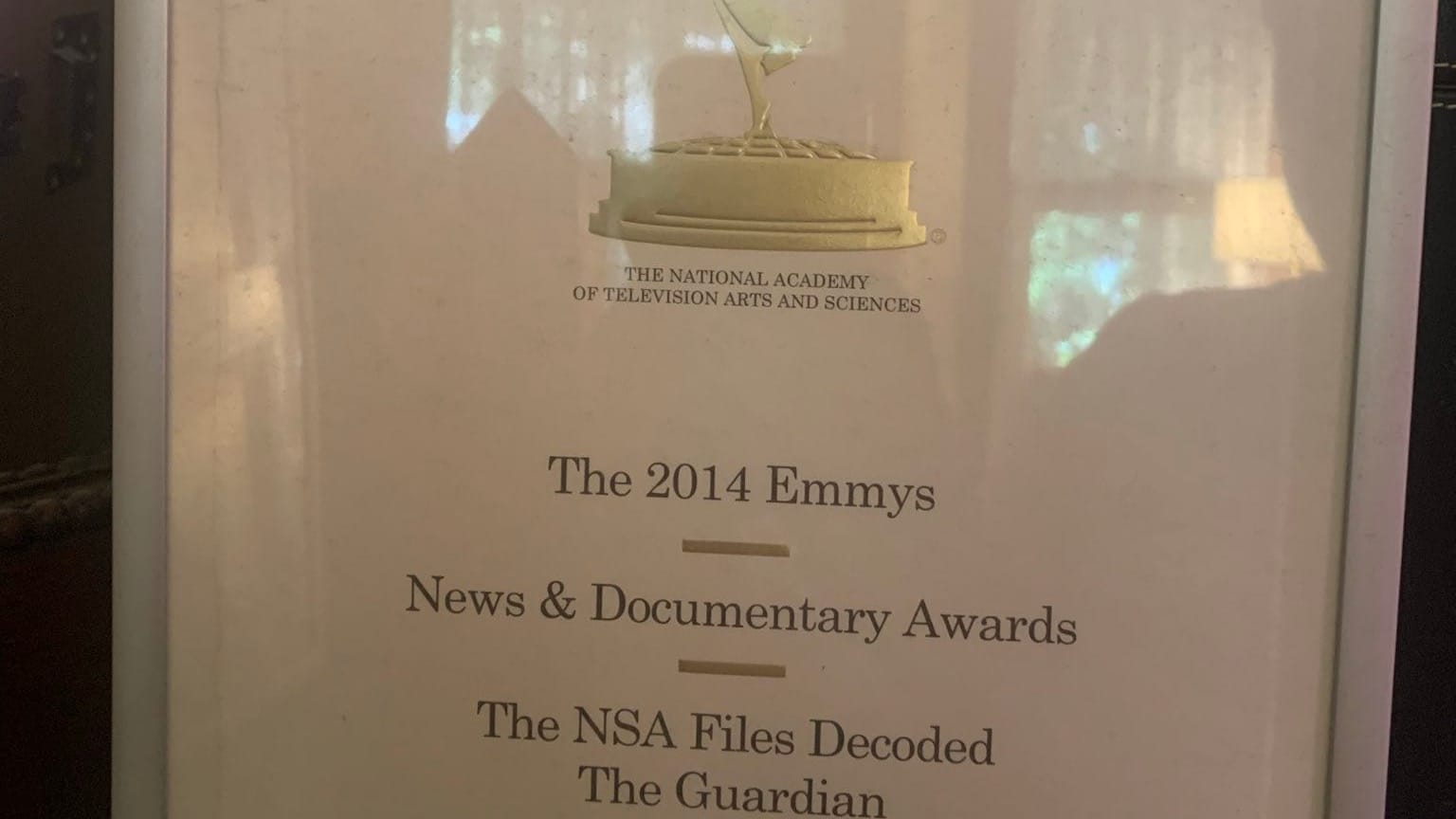They Have To Call Bisan Owda A Terrorist
A young journalist living through a genocide documents the reality of life in Gaza. I'll destroy my Emmy if they rescind her nomination

A young journalist living through a genocide documents the reality of life in Gaza. I'll destroy my Emmy if they rescind her nomination
Edited by Sam Thielman
EVERY DAY, WHEN I WAKE UP, I reach for my phone, blearily place my thumb on the Instagram icon, and make sure that Bisan Owda is still alive.
The baby-faced, braces-mouthed Owda, whom Wikipedia tells me is 25 or 26 years old, has become one of several crucial Palestinian voices narrating for the outside world, in English, the reality of life in Gaza. Owda and the de facto Gaza press corps, like Hind Khoudary, Plestia Alaqad, and Wael al-Dahdouh, are in my opinion the most important journalists in the world. They show from the people's perspective what the Israeli collective punishment of Gaza truly is, not how the Israeli and U.S. governments prefer to portray it. If Palestinian life in Gaza is not already subject to a death sentence, Palestinian journalism most certainly is. I am grateful that I can't truly comprehend the bravery that Bisan and her colleagues routinely summon.
Owda is nominated for an Emmy for her Peabody-winning reports, It's Bisan from Gaza And I'm Still Alive. Yet on Monday, an open letter from Hollywood celebrities who deceitfully portray themselves as for "peace"—meaning the graveyard Israel, with U.S. weaponry, is making of Gaza—objected to her nomination. They claim that Owda should be disqualified because, per the New York Times, that Owda is "affiliated" with the Popular Front for the Liberation of Palestine, because "reports and photographs indicat[e] that Owda spoke at group events between 2014 and 2018." What else could they call her but a terrorist?
So if Wikipedia is correct, then Bisan… spoke at PFLP events when she was a teenager. Clicking through one of the Times links, they say the PFLP in 2018 referred to Owda as a member of the Progressive Youth Union, which I gather is supposed to be their youth wing —so, when she was 19 or 20. Out of this thin gruel, which includes not a single act they allege her to have committed, they portray her as a terrorist and an antisemite. The real reason they're trying to discredit Owda is revealed through a quote the head of the group issuing the open letter gave the Times:
“[W]hat you see with someone like her,” [Ari Ingel] said of Owda, “is infusing some legitimate news stories with the propaganda twist and spin of ‘genocide,’ which is being taken as truth.”
There it is. Owda, like Omer Bartov, calls what she is experiencing a genocide. That is why she has to be discredited, and the genocide deniers will stretch as far as they need to stretch to come up with the "affiliations" necessary to make organizations like the National Academy of Arts & Sciences fearful of lending such a person its imprimatur. So far, it doesn't appear to be working. But the tactics of the post-9/11 era—and indeed before it, as far as the Palestinians are concerned—provide the template for this inevitable slander. The heavy lifting is accomplished through the acquiescence of well-meaning people who encounter the slander and conclude that whatever the truth, Bisan Owda is too controversial to defend.
I trust instead the evidence of my own eyes and ears, having watched her videos for the better part of a year. What I have seen is a young journalist who does not stop reporting despite being reduced to carrying all her belongings on a dangerous trek and then living in a tent. Bisan gives no evidence of hating Jews like me for being Jews. She reveals what Israel is doing to Palestinians like her for being Palestinians. I would never begrudge her any hate toward her oppressors she may feel, but her videos are not heated hateful rants, they're depictions of the horror Israel inflicts around her, in which she expresses the agony of living in a crucible. In the attacks on her as a terrorist "affiliate"– notice how much innuendo and how little specificity that word contains – I see the imprisonment of Adham Hassoun through retroactive PATRIOT Act criminalization, and the persecution of Sami al-Arian. Both Adham and Sami are Palestinians.
Anti-Zionism is not antisemitism. Antisemitism can indeed creep into anti-Zionism if anti-Zionists are not vigilant, but I've been impressed over the past year with the vigilance of those within pro-Palestinian circles who consider antisemitism both odious and a threat to discredit the movement. I know what antisemitism truly is: It's what the wealthiest man on the planet espouses while a supposed institutional defender of the Jewish American community blocks and tackles for him, all so he will suppress the testimonies of people like Bisan. This is not the Jewish tradition. This is a betrayal of Jewish tradition, from people who know better, and for whom no expression of Palestinian identity can be acceptable outside of a museum.
A decade ago, I unexpectedly won a piece of an Emmy, thanks to my work on a Guardian team that turned the Edward Snowden disclosures into an easy-to-follow online documentary. Since it was a team award, I don't have the statue—that's at the Guardian offices—but we awardees each got a framed print to put on our mantles. Never in my life did I expect to call myself in any way, shape or form, an Emmy winner, and I get a kick out of this unlikely award.
Right now, the Academy is defending Bisan's nomination. But character assassination is a marathon, not a sprint, and who knows how much fortitude the Academy is willing to show. Should it end up removing Bisan from the list of nominees, I will take my Emmy award out of its frame and burn it. That is what the Emmy will be worth, should the Academy decide it's too great a reputational risk to acknowledge one of the bravest and most intrepid journalists still alive.
PETER BEINART, on the eve of the Democratic National Convention, powerfully deploys understatement against the narrative that Joe Biden, facilitator of a genocide against Palestinians, is any kind of hero. It's a worthwhile video. I didn't watch Biden's speech to the DNC, because now that I no longer work for news organizations that require me to do so, I have zero interest in watching party conventions. Follow Zeteo's Prem Thakkar for that instead.
CAROLE CADWALLADR, scourge of Cambridge Analytica, had a bracing Guardian op-ed on Sunday warning that the social-media/right-wing media ecosystem that produced days of anti-immigrant and Islamophobic pogroms in the United Kingdom could represent a proof of concept for Elon Musk in his attempts to influence U.S. politics.
DANIEL LARISON has a good piece assessing the Biden administration's "bridge proposal" in what appear to be failing ceasefire negotiations. As Larison writes, it's a bridge not between Israel and Hamas, but between the U.S. and Israel, as Netanyahu's additional conditions (such as Israeli military control of the Philadelphi corridor and the Rafah Crossing between Gaza and Egypt; as well as the Netzarim corridor bisecting Gaza) are designed to make it impossible for Hamas to accept. There is no evident movement from Israel—nor evident U.S. pressure on Israel—to trade a permanent ceasefire for the remaining hostages, which FOREVER WARS told you in June would be the crucial impasse. "We don't need new Gaza cease-fire negotiations, we need to agree on an implementation mechanism," Hamas mouthpiece Osama Hamdan said Monday.
Larison:
The theater of [Secretary of State Antony] Blinken’s bridge is meant to give Netanyahu political cover and to delay Iranian retaliation for the attack in Tehran. The administration keeps running the same play so that it can claim to be working to end the war while doing nothing to pressure the Israeli government to end it.
There are worse things than attempting to delay Iranian military retaliation. But there is only one way to prevent that retaliation, and the U.S. keeps not fucking doing it, which ensures that people will continue to die. "All of Netanyahu’s attempts to sabotage the negotiations should stop. Deal now, before they all die," Israeli opposition leader Yair Lapid said on Tuesday. (I assume by "they" Lapid only means the hostages, but his statement also applies to the Palestinians of Gaza.)
TAREQ BACONI has thundering line after thundering line in his New York Review of Books assessment of Hamas after the Ismail Haniyeh assassination. This observation struck me as crucial:
[New leader Yahya] Sinwar’s political makeup differs from that of Haniyeh, who was not a part of the military wing but operated mostly above ground as a diplomat and political functionary. His rise means that, for the first time since [2004, following Israel's assassination of predecessor Abdul Aziz] Rantissi, Hamas’s leadership is based in Gaza rather than in the diaspora and held by a member of the military rather than political wing. The implications of this shift are clear: it reiterates the movement’s commitment to armed resistance, connects the leadership more directly and closely to its constituents in Gaza rather than regional powers, and moves the center of gravity toward military rather than diplomatic or political considerations.
I don't want to reduce Baconi's piece to what struck my eye, but that seems like important context for understanding Hamas going forward. Baconi's piece also introduced me to Sinwar's only Hebrew-language-media interview, given to Yedioth Aranoth in 2018 (possibly without Sinwar knowing who was publishing it), when Sinwar stated about explosive-laded kites and balloons that Hamas was sending into southern Israel: "The kites and balloons are not a weapon, they are a message: You are stronger than us where it’s not even comparable, but you will never, ever win." Benjamin Netanyahu cannot destroy Hamas, but he sure did make it so that Sinwar and the military faction of Hamas achieved internal power.
DURING THE BUSH ADMINISTRATION, sentencing within the criminal justice system for those convicted of crimes related to terrorism often came with expansive internal surveillance and severe restrictions on access to the outside world. Within the federal prisons at Marion, Illinois, and Terre Haute, Indiana facilities were constructed for that purpose, known as a CMU, for Communications Management Unit. Not only did the CMUs blur the lines between conditions in federal prison and conditions within Guantanamo Bay—they became known as Little Guantanamos—but they were an example of an inherently discriminatory and unequal treatment. Something like 70 percent of inmates in the early years of the CMUs were Muslim. If you read REIGN OF TERROR, you know that Adham Hassoun was imprisoned for years at the Marion CMU.
Now, an investigative team writing for The Nation and The Appeal have committed a real public service by uncovering massive growth in CMU incarcerations—for those not convicted of terrorism-related offenses. "According to the most recent data, obtained by public records request, the number of people incarcerated in CMUs between 2007 and 2022 has increased 140 percent," they write, and they're becoming a disciplinary measure to punish those who have expressed a strong opposition to American foreign policy," like Daniel Hale. It turns out not exactly to be better that Muslims are now more like a third of total CMU inmates.
This is a tremendous piece of journalism and a frightening example of how once the psychotic tendencies of the War on Terror are normalized and institutionalized, they widen the aperture of their ambitions to other targets. [As a lover of raw data, I just have to interject that if you want to go through the information yourself, the Nation/Appeal piece was written in cooperation with Syracuse University’s amazing Data Liberation Project, which posts its findings here.—Sam.]
AS THE U.S. MILITARY'S AFRICA COMMAND gets kicked out of countries that used to provide it with airbases, it wants to replace its drone fleet—want to feel old, and also hopeless? The Predator replacement, the Reaper, is now a legacy platform coming to the end of its service life—with something that can stay in the air "well beyond three days."

